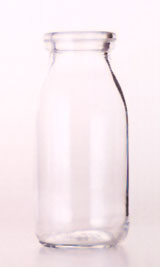 |

|
 |
 |
|

|
 |
 |
Product Category/ Family Use Group
01A20498
50% Lightweighted small size milk bottle / Z200
Applicant: Toyo
Glass Co.,Ltd.
Designer: TOYO GLASS CO.,LTD. Glass Container Market Development Department Hitomi Abe |
This is a small, lightweight, returnable milk bottle that is
easy to carry and easy to pick up. It is the first bottle in
the industry to achieve a 50% reduction in weight, which means
that it is not only useful for people who drink milk but also
reduces the amount of energy that people need to expend in transportation.
In order to give the bottle its sophisticated lightweight form,
the designers took care to reduce the circumference of its mouth
and reshape it, trying as much as possible to create an unforced
design that still has the user appeal of conventional milk bottles.
Since its mouth allows the use of both paper stoppers and plastic
caps, the bottle is adaptable to a broad range of uses. We were
favorably impressed by the improvements in both technology and
form, by the efforts to conserve resources and reduce weight,
and by the presentation of a product that serves as a sophisticated
example of universal design.
|
 |
This is a proposal for a system that serves as the basis of
a support mechanism to be worn on the affected body part of
a person with decreased motor functions. The development of
wearable mechanical elements is an important aspect of providing
support for mobility during athletic training or for elderly
or disabled people. Yet the aim of this particular suit is the
development of a new, small, lightweight, flexible component
that offers gentle interaction with the human body, especially
in ways of wearing it. The designers have therefore developed
and proposed a wearable supplementary muscle system by a safe
method employing air pressure. We gave this project high marks
for imagining new concepts in robotics, through the development
of robot elements in extremely close contact with the human
body, and for embodying the principals of universal design in
a proposal for cutting-edge technology that anyone can use,
especially the elderly and disables. |
|
 |
|
|